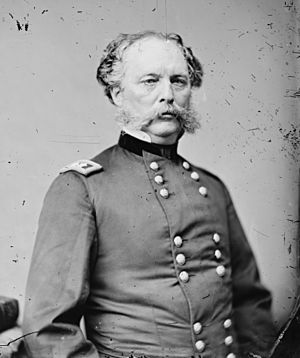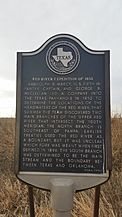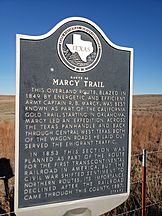Randolph B. Marcy facts for kids
Quick facts for kids
Randolph Barnes Marcy
|
|
|---|---|

Randolph B. Marcy
|
|
| Born | April 9, 1812 Greenwich, Massachusetts |
| Died | November 22, 1887 (aged 75) West Orange, New Jersey |
| Place of burial | |
| Allegiance | United States of America Union |
| Service/ |
United States Army Union Army |
| Years of service | 1832–1881 |
| Rank | |
| Unit | 5th U.S. Infantry |
| Commands held | Inspector General of the U.S. Army |
| Battles/wars | Black Hawk War Mexican–American War Utah War American Civil War |
| Other work | author |
Randolph Barnes Marcy (born April 9, 1812 – died November 22, 1887) was an important officer in the United States Army. He is best known for writing a famous guidebook called The Prairie Traveler in 1859. This book helped thousands of people travel safely across the American West. During the American Civil War, Marcy worked closely with his son-in-law, General George B. McClellan. Later, he became the Inspector General of the U.S. Army, which meant he checked how the army was doing.
Contents
About Randolph Barnes Marcy
Randolph Barnes Marcy was born in Greenwich, Massachusetts. He studied at the United States Military Academy at West Point and finished in 1832. After graduating, he became a lieutenant in the 5th U.S. Infantry. He got married soon after, and his daughter, Ellen Mary, later married George B. McClellan, who would become a famous general.
Early Military Career
Marcy's first experience in battle was during the Black Hawk War in Illinois and Wisconsin. Later, he was promoted to Captain in the Mexican–American War. He fought in important battles like Palo Alto and Resaca de la Palma.
After these wars, Marcy was sent to Texas and Oklahoma. His job there was to help people moving west, find good places for army forts, explore new areas, and map out travel routes. In 1852, he led an expedition that found the starting points of both parts of the Red River. It was during this trip that he met George B. McClellan.
The Utah Expedition
In 1857, Marcy joined Brigadier General Albert Sidney Johnston on an expedition against the Mormons in Utah. During this journey, Marcy showed great leadership. He led his troops safely through the Rocky Mountains in the middle of winter, even after they had run out of food for two weeks.
His achievements and well-written reports caught the attention of people in Washington, D.C. He was called back to work for the Department of State. There, he wrote his famous guidebook about the western trails.
The Prairie Traveler Guidebook
Marcy's book, The Prairie Traveler: A Handbook for Overland Expeditions, with Maps, Illustrations, and Itineraries of the Principal Routes between the Mississippi and the Pacific, was published by the U.S. Government in 1859.
This book quickly became a must-have guide for thousands of Americans. They used it to travel to places like California, Oregon, and Utah. The book was based on Marcy's own many experiences exploring the frontier. It gave important advice on:
- How to explore new areas
- Skills for living in the wilderness
- What food and supplies to bring
- How to stay healthy on long trips
The guide helped save many lives on these dangerous routes. It covered topics like hunting, tracking, and finding food and water. It also gave special advice on choosing horses, avoiding quicksand, understanding smoke signals, and using sign language. The book was a bestseller for the rest of the 1800s.
A historian named Andrew J. Birtle called The Prairie Traveler "perhaps the single most important work on the conduct of frontier expeditions published under the authority of the War Department."
Later Career and Retirement
After finishing his famous book, Marcy was promoted to major. He was sent to the Pacific Northwest to work as a paymaster, handling army payments. When the Civil War began, he returned East. He became the chief of staff for his son-in-law, General McClellan.
By the end of the war, he was the Inspector-General of the U.S. Army. In 1868, he was given the honorary rank of major general of volunteers (back-dated to 1865). He became a brigadier general in the U.S. Army in 1878. Marcy continued to serve until he retired in 1881.
Legacy
Several things are named in honor of General Marcy:
- Fort Marcy Park in McLean, Virginia, is named after him.
- A type of garter snake, called Thamnophis marcianus, is also named after him.
See also
 In Spanish: Randolph Barnes Marcy para niños
In Spanish: Randolph Barnes Marcy para niños



